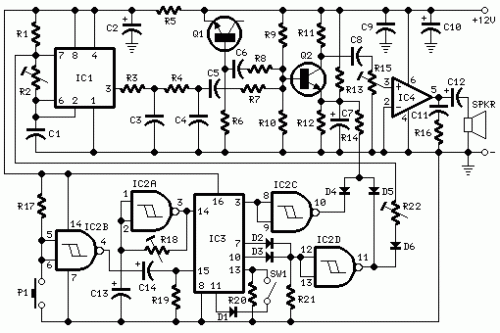Agreeable, very close sound imitation
Suitable for sound effects, door-bells etc.
Circuit diagram

Parts:
R1,R5 1K 1/4W Resistors
R2 50K 1/2W Trimmer Cermet
R3 8K2 1/4W Resistor
R4 82K 1/4W Resistor
R6 1M 1/4W Resistor
R7,R17,R20,R21 22K 1/4W Resistors
R8,R10,R11,R19 10K 1/4W Resistors
R9 150K 1/4W Resistor
R12 4K7 1/4W Resistor
R13 100K 1/4W Resistor
R14 220R 1/4W Resistor
R15,R22 20K 1/2W Trimmers Cermet
R16 10R 1/4W Resistor
R18 200K 1/2W Trimmer Cermet
C1,C11 47nF 63V Polyester or Ceramic Capacitors
C2,C10,C12 220µF 25V Electrolytic Capacitors
C3 220nF 63V Polyester or Ceramic Capacitor
C4 22nF 63V Polyester or Ceramic Capacitor
C5,C6,C8,C9 100nF 63V Polyester or Ceramic Capacitors
C7,C13,C14 10µF 63V Electrolytic Capacitors
D1,D2,D3,D6__1N4148 75V 150mA Diodes
D4,D5 BAT46 100V 150mA Schottky-barrier Diodes
Q1,Q2 BC547 45V 100mA NPN Transistors
IC1 7555 or TS555CN CMos Timer IC
IC2 4093 Quad 2 input Schmitt NAND Gate IC
IC3 4017 Decade counter with 10 decoded outputs IC
IC4 LM386 Audio power amplifier IC
P1 SPST Pushbutton
SW1 SPST Switch
SPKR 8 Ohm Loudspeaker
Comments:
This circuit generates a two-tone effect very much alike the cuckoo sound. It can be used for door-bells or other purposes thanks to a built-in audio amplifier and loudspeaker
Used as a sound effect generator it can be connected to external amplifiers, tape recorders etc. In this case, the built-in audio amplifier and loudspeaker may be omitted and the output taken from C8 and ground.
There are two options: free running, when SW1 is left open, and one-shot, when SW1 is closed. In this case a two-tone cuckoo sound will be generated each time P1 pushbutton is pressed.
Circuit operation:
IC1 is wired as a squarewave generator and produces both tones of the cuckoo sound. The frequency of the higher one (667Hz) is set by means of Trimmer R2. When IC2D output goes low, a further Trimmer (R22) is added to IC1 timing components via D6, and the lower tone (545Hz) is generated.
To imitate closely the cuckoo sound, the squarewave output of IC1 is converted to a quasi-sinusoidal waveform by R3, R4, C3 and C4, then mixed with the white noise generated by Q1, R6.
Q2 has two purposes: it mixes the two incoming signals and gates the resulting tone, shaping its attack and decay behavior by means of the parts wired around its Emitter.
IC4 is the audio power amplifier driving the speaker and R15 is the volume control.
The various sound and pause timings for the circuit are provided by the clock generator IC2A driving the decade counter IC3. Some output pins of this IC are gated by IC2C, IC2D and related components to drive appropriately the sound generator and the sound gate.
When SW1 is left open the circuit operates in the free-running mode and a cuckoo sound is generated continuously. When SW1 is closed, the circuit generates two tones then stops, because a high state appears at the last output pin (#11) of the decade counter IC: therefore the count is inhibited by means of D1 feeding pin #13.
The circuit is reset by a positive pulse at pin #15 of IC3 when P1 is pressed.
Setup:
Best results will be obtained if the two tones frequencies are set precisely, i.e. 667Hz for the first tone and 545Hz for the second: in musical terms this interval is called a Minor Third. Obviously a digital frequency counter, if available, would be the best tool to setup R2 and R22, but you can use a musical instrument, e.g. a piano or guitar, tuning-up the notes accurately by ear.
Disconnect temporarily R22 from D6 anode
Connect the digital frequency counter to pin 3 of IC1
Adjust R2 in order to read 667Hz on the display
Connect R22 to negative ground and adjust it to read 545Hz on the display
Restore R22 - D6 connection
Tuning by ear:
Disconnect temporarily R22 from D6 anode
Disconnect C8 from Q2 Collector and connect it to R4, C4 and C5 junction
Adjust R2 in order that the tone generated by the loudspeaker is at the same pitch of the reference note generated by your musical instrument. This reference note will be the E written on the stave in the fourth space when using the treble clef
Connect R22 to negative ground and adjust it in order that the tone generated by the loudspeaker is at the same pitch of the reference note generated by your musical instrument. This second reference note will be the C-sharp written on the stave in the third space when using the treble clef
Restore R22 - D6 and C8 to Q2 Collector connections
Notes:
The master clock can be adjusted by means of R18.
The percentage of hiss and sound in the mixing circuit, setting the tone character, can be varied changing R8 and R7 values respectively.
Any kind of dc voltage supply in the 12 - 15V range can be used, but please note that supply voltages below 12V will prevent operation of the white noise generator.
An amusing application of this circuit is to use a photo-resistor in place of P1, then placing the unit near the flashing lamps of your Christmas tree. A sweet cuckoo sound will be heard each time the lamp chosen will illuminate.
author: RED Free Circuit Designs
e-mail:
web site:
http://www.redcircuits.com/
 Audio (49)
Audio (49) Power & high voltage (43)
Power & high voltage (43) Radio (23)
Radio (23) Light & LED (31)
Light & LED (31) Tools & measurement (40)
Tools & measurement (40) Telephone (18)
Telephone (18) Automotive (10)
Automotive (10) Microcontrollers (12)
Microcontrollers (12) Sensors & control (47)
Sensors & control (47) Timers & oscillators (40)
Timers & oscillators (40) Miscellaneous (26)
Miscellaneous (26)
